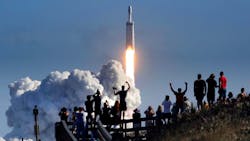It’s the biggest game in town for now, but has not flown in more than three years. Fans of SpaceX, though, will have a chance to see what is currently the most powerful rocket in use launch on a mission from Kennedy Space Center on Tuesday.
SpaceX said it was targeting Nov. 1 for the launch, but did not specify a time in a post late Thursday to Twitter saying it had successfully completed the Falcon Heavy static fire. Website SpaceFlight Now reports that the target liftoff is 9:40 a.m.
The Space Launch Delta 45 weather squadron should put out a warning by Saturday for aircraft and boats to stay out of the range along with a three-day forecast for weather that will include a launch window.
“This launch culminates years of effort by a dedicated team comprised of mission-focused people from across the U.S. Space Force and SpaceX,” said SLD 45 commander Brig. Gen Stephen Purdy on Thursday. “The Falcon Heavy is an important element of our overall lift capability, and we’re very excited to be ready for launch.”
What’s going up is the USSF-44 mission, the first of three Department of Defense flights planned to fly on the Falcon Heavy, which is essentially three Falcon 9 rockets strapped together using 27 Merlin engines to produce 5.1 million pounds of thrust at liftoff with the capability to bring payloads to higher orbits.
USSF-44 will be the first National Security Space Launch for Falcon Heavy with future missions USSF-67 and USSF-52 booked, but without a target launch date yet, according to Space Force officials. It comes more than three years since Falcon Heavy’s last launch in June 2019 that released 24 experimental satellites into orbit for the Department of Defense’s Space Test Program, and paved the way for these missions for Space Force’s Space Systems Command.
Space Systems Command, which is headquartered at Los Angeles Air Force Base in California, is responsible for “rapidly developing, acquiring, equipping, fielding and sustaining lethal and resilient space capabilities,” according to a Space Force press release. Its responsibilities include “launch acquisition and operations; communications and positioning, navigation, and timing; space sensing; battle management command, control, and communications; and space domain awareness and combat power.”
The top secret payloads are identified simply as “multiple satellites” for the Space Systems Command’s Innovation and Prototyping Delta. Their final destination will be at a much higher altitude than the low-Earth orbit placement for satellites such as SpaceX’s Starlink internet satellites.
The launch profile calls for more fuel from the central booster so that SpaceX won’t even attempt to recover it like normal. It will attempt to land the two side boosters, though, at the landing complex at Cape Canaveral Space Force Station, which could bring a couple of double sonic booms to the Space Coast upon return.
“Our launch and mission assurance team and SpaceX, along with the fantastic crew at Space Launch Delta 45, have done an absolutely superb job preparing this rocket,” said Col. Douglas Pentecost, SSC’s Deputy Program Executive Officer for Assured Access to Space. “We put important national capabilities into space to address the threat, and working together we ensure 100% mission success.”
Falcon Heavy has only flown three times previous with its first launch in 2018 sending up Elon Musk’s Tesla roadster, which is currently in an orbit that at times takes it beyond Mars. It then flew a commercial payload in April 2019 to put the Arabsat-6A satellite into orbit followed by the DOD mission called Space Test Program-2 in June 2019.
As far as thrust goes, Falcon Heavy more than doubles the power of United Launch Alliance’s Delta IV Heavy, but falls short of the more than 7 million pounds of thrust produced during Space Shuttle Program launches and 7.6 million pounds of thrust seen from the Apollo program’s Saturn V rockets.
It will also be outpaced by NASA’s new Space Launch System rocket that will produce 8.8 million pounds of thrust at liftoff, which would make SLS the most powerful rocket to ever lift off from Earth, if it can get off the ground next month. NASA is planning a launch of SLS on the Artemis I mission as early Nov. 14.
Also in the works is the new SpaceX Starship rocket that when combined with the Super Heavy booster will leave Falcon Heavy, SLS, the shuttle and Saturn V rockets in the dust, capable of producing more than 16 million pounds of thrust through 33 Raptor engines. That could make its first orbital test flight before the end of the year as well from SpaceX’s southeast Texas facility Starbase.
For now, though, Falcon Heavy is the king of active rockets and ready to fly from KSC’s Launch Pad 39-A.
©2022 Orlando Sentinel. Visit orlandosentinel.com. Distributed by Tribune Content Agency, LLC.



